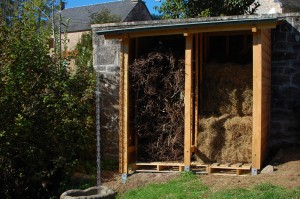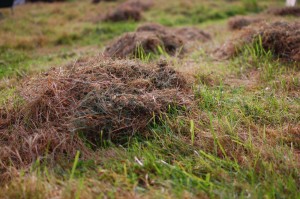 We had a few basic requirements when searching for a new home. On my list, towards the top, were (A) the possibility of leaving a decent-sized meadow area to grow wild, and (B) an interesting hedge. I’m fairly low maintenance.
We had a few basic requirements when searching for a new home. On my list, towards the top, were (A) the possibility of leaving a decent-sized meadow area to grow wild, and (B) an interesting hedge. I’m fairly low maintenance.
In addition to the house, we ended up with a useful south-facing plot of around 1500m² that is largely given over to grass. Oh, and a young hedge that was obviously planted by someone with similar interests and aesthetic requirements.
Leaving the grass to do its thing has been interesting. With the exception of a small area near to the ancient hazel stools, there is not a level piece of ground on the plot, and the grasses and flowers that grow here have organised themselves into quite distinct zones dictated by the contours and conditions.
Close to the house, on the higher ground, in full sun for the whole day, the grasses are dominated by a dense, rich yellow-green variety that sprouts strong stems growing waist-high. Down in a damp cutting that is shaded early in the morning and from late afternoon, a vigorous leafy thistley plant dominates. Beyond that, in an area that is sheltered from the winds by a tall Beech hedge, whispy, feathery, creamy grasses have made their home. In the flat area that rarely sees direct sunlight for long periods, being shaded by two large Oaks, and by the Hazel when mature, clovers are happiest.
Every few weeks or so from spring onwards, I strim a wide path around the perimeter, and a couple through the center, allowing us to wander around and take a look at what has appeared this month, this week, oh, look, today.
Along with newly-sprouted grasses and flowers come the insects and creatures that are supported by them. Impossibly coloured butterflies. Beetles that must consume a lifetime’s energy simply crossing the seemingly impenetrable forest, in search of … what ? A seething nest of forest ants building an ever-larger mound that is supplied by single-row highways of workers that spend all day every day collecting bits of this and that from beyond the boundary. Many varieties of bee hovering, collecting.
Anyway, the point is this. At summer’s end, when the grasses die back, the entire lot is strimmed, to be stored and used as cover material for the dry toilet compost bins ( see humanurehandbook.com ).
Last year, owing to lack of time, we simply stored the considerable heap within a crude chicken wire enclosure and covered it with tarpaulin. This did a reasonable job, but because it was stored loose, and the tarpaulin let in a certain amount of water, the bottom of the pile was on its way to compost status by the time we got to it.
So, this year we decided to store it as small bales in a shed constructed specifically for that purpose. The trouble is, the plot is not really large enough, or practical enough in layout, to be able to bale with a tractor. What to do ?
Think laterally is our stock response, often with better than expected results. We had devised an alternate use for our Truncator when bundling faggots earlier in the year. The process worked so well that we revisited and revised it for this task.
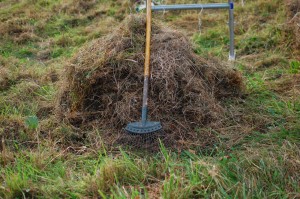 First, gather the piles of cut well-dried grass into larger bundles.
First, gather the piles of cut well-dried grass into larger bundles.
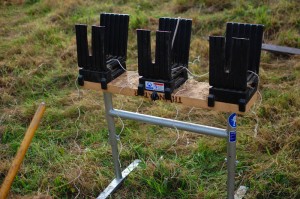 Lay three pieces of twine ( two for the short sides, one for around the entire length ) into the Truncator.
Lay three pieces of twine ( two for the short sides, one for around the entire length ) into the Truncator.
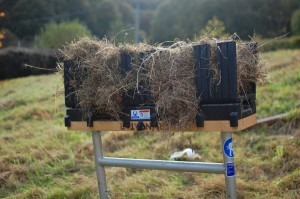 Densely pack the grass into the buckets; it’s surprising how much you can cram in. Packing it densely greatly reduces the volume of material coming into contact with oxygen. This, together with dry storage, lessens the likelihood of the material composting down before needed. Tie with twine.
Densely pack the grass into the buckets; it’s surprising how much you can cram in. Packing it densely greatly reduces the volume of material coming into contact with oxygen. This, together with dry storage, lessens the likelihood of the material composting down before needed. Tie with twine.
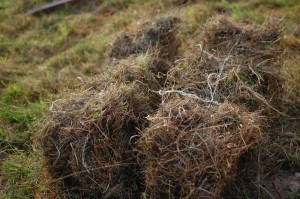 Remove and repeat. Our Truncator is set up to handle meter lengths of wood, and so the resulting bales are formed to this useful, manageable size.
Remove and repeat. Our Truncator is set up to handle meter lengths of wood, and so the resulting bales are formed to this useful, manageable size.
This little construction’s dimensions were dictated by the 2.5m lengths of wood we bought, and the sheets of corrugated steel left over after we replaced the temporary wood shelter with a fancy permanent shed.
As luck would have it, the dimensions allowed for the creation of two perfectly-sized 1m partitions. Next to the bales are stored the Hazel faggots. The chain link ‘downpipe’ was added following a moment of divine inspiration.

